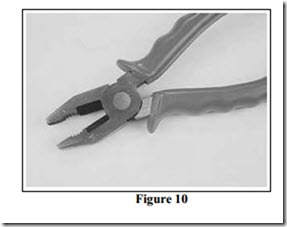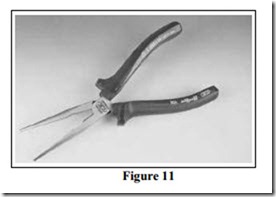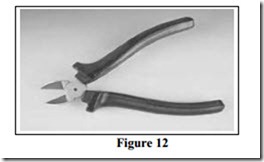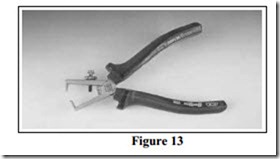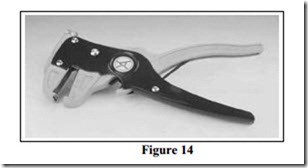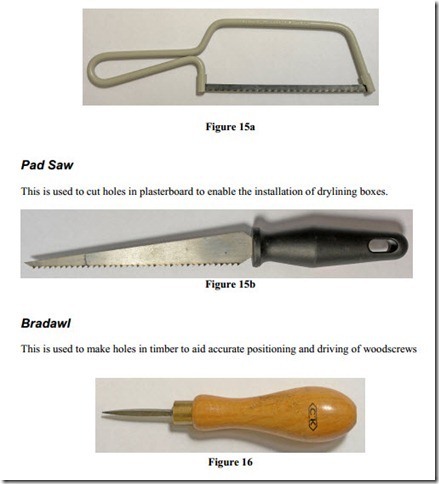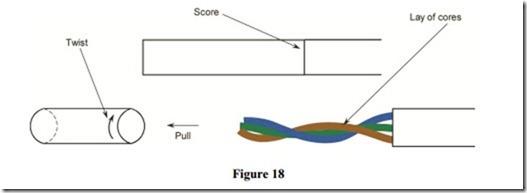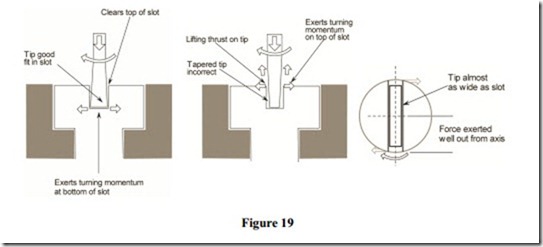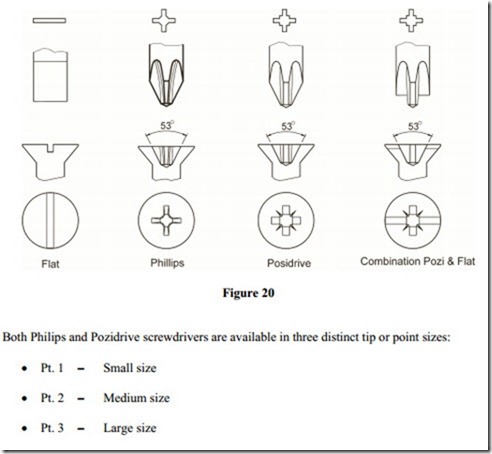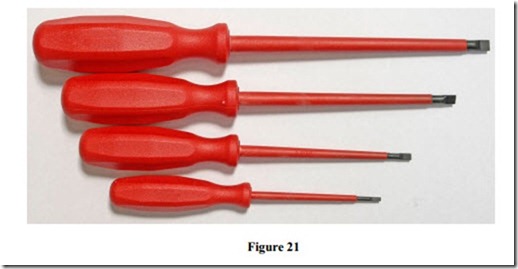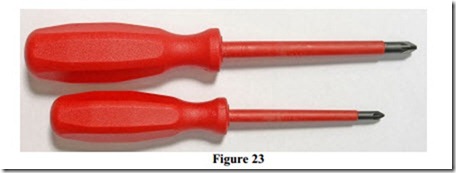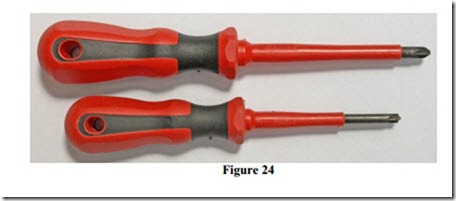Use of Hand Tools
An electrician can often be judged by his appearance and by the tool kit with which he carries out his work. Clothing should be neat and tidy and kept in this manner by using an overall when necessary. Tool kit should contain all the necessary gear to do the work correctly and efficiently.
These have serrated jaws and are used for gripping, twisting and bending conductors. They also have a curved section, serrated for gripping round metal items. A wire cutter is also provided. See Figure 10.
These are used for fine work where the electrician’s pliers are too large and for guiding conductors into terminals etc. They are available with additional features such as small lug crimpers. See Figure 11.
Commonly referred to as “snips”, these are used to cut small cables and conductors, and to trim insulation. See Figure 12.
These are used to strip insulation from conductors. The adjusting screw should be used to prevent the cutting tips doing damage to the conductor. They may also be used to remove the sheath from single core PVC / PVC cable, 1.5mm2 and 2.5mm2, while leaving the insulation intact. See Figure 13.
Automatic Wire Stripper
Another form of wire stripper is the automatic wire stripper. See Figure 14. This tool is designed to remove insulation from a range of conductor sizes.
Junior Hacksaw
This is used to cut the larger size cables, cut mini trunking and cut out openings in surface boxes for cable entry.
A good quality electrician’s penknife is mainly used to remove the sheath from the various types of cables and flexible cords.
This is best done by scoring round the sheath at the point to which it must be removed. Be careful not to cut through the sheath, damaging the insulation. In some cases, the sheath can then be removed, by flexing gently at the scored point until it yields. Then pull while twisting to follow the lay of the cores. See Figure 18.
If the sheath is too long or too tough to be removed in this manner, it will have to be slit along its length to remove it.
Screwdrivers
There are a wide variety of types and sizes of screwdriver, some of which have very specialised uses, e.g. tamper proof fixings.
Flat blade screwdrivers are still in common use today in the electrical trade. They are specified in size, by the length of the blade and the width of the tip. A set consisting of at least five would be suitable for electrical work.
Screwdrivers should not be used as chisels. Larger sizes may be used to advantage for some levering operations, but great care must be taken to avoid damage to the shaft or tip.
The tip of the screwdriver should fit the screw head accurately, to achieve maximum drive and avoid damage to the screw head. See Figure 19.
Philips and Pozidrive Screwdrivers
The Philips screwdriver has been in use for a long period of time. It has the advantage in that it can be very simply and quickly located in the screw head. Its main disadvantage is that it has wings, which are tapered. These tend to cause the tip of the screwdriver to be forced up out of the screw head, when a turning effort is applied.
A variation and indeed an improvement on the Philips screwdriver, is the Pozidrive type. These are very similar in appearance. The main difference between them is the fact that the Pozidrive has wings, which are parallel. These provide a better grip and do not cause the tip of the screwdriver to be forced up out of the screw head.
It is important to be able to identify which type of screw head is present and then choose the correct type of screwdriver to prevent damage to the screw head. See Figure 20.
It is obviously very important to choose the correct tip size also.
Remember that terminal screws may be used several times due to maintenance work or alterations to circuits. The use of a screwdriver of the wrong size or type will damage the screw head and render the piece of equipment useless.
Flat Blade Screwdrivers
Figure 21 illustrates a set of terminal screwdrivers which are suitable for general electrical work. They have insulated shafts and tip sizes of 6, 5, 4 and 3 mm.
Phase Tester
Figure 22 illustrates a phase tester, which doubles as a small terminal screwdriver. It is a very useful tool when checking if a circuit is “live” or not. It is very important to ensure that it is not used in a damp or wet condition. When in use, current flows through the body of the user. Dampness may increase this operating current to a dangerous level.
Pozidrive Screwdrivers
Figure 23 illustrates a size 2 and size 1 Pozidrive screwdriver. Most woodscrews now in use are pozidrive type. A Philips screwdriver will simply slip causing damage to the screw head. The same information applies to terminal screws. The length of the shaft and the tip size are marked on the handle of most screwdrivers.
Combination Flat and Pozi Screwdrivers
Figure 24 illustrates a size 2 and a size 1 combination Flat and Pozi screwdriver. Most manufacturers of electrical protective devices are now using a screw head which will accept a Flat tip screwdriver or a Pozidrive type. This combination screwdriver provides an excellent grip and can be used numerous times without damage to the screw head.
